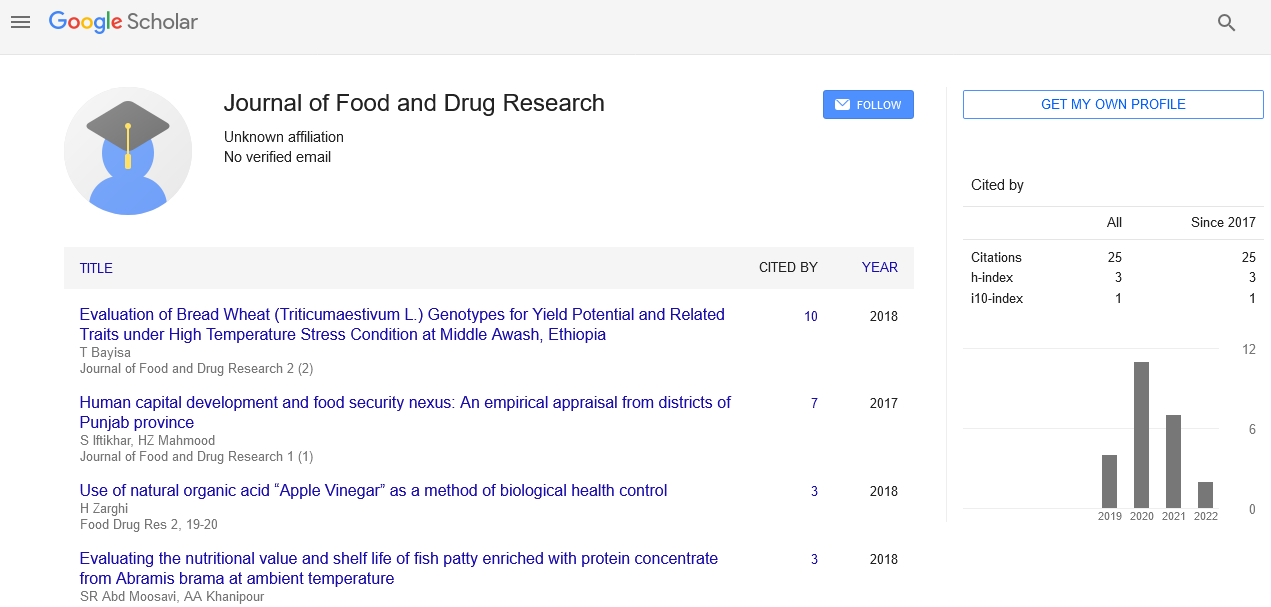Food safety behavioural changes among the population in Sub-Saharan Africa during the COVID-19 first wave
Received: 23-Apr-2022, Manuscript No. PULJFDR-22-5378; Editor assigned: 25-Apr-2022, Pre QC No. PULJFDR-22-5378 (PQ); Accepted Date: May 06, 2022; Reviewed: 02-May-2022 QC No. PULJFDR-22-5378 (Q); Revised: 04-May-2022, Manuscript No. PULJFDR-22-5378 (R); Published: 07-May-2022, DOI: 10.37532/puljfdr.22.6(3).1-2
Citation: Watson U. Food safety behavioural changes among the population in sub-saharan africa during the covid-19 first wave J. Food Drug Res.2022; 6(7):1-2.
This open-access article is distributed under the terms of the Creative Commons Attribution Non-Commercial License (CC BY-NC) (http://creativecommons.org/licenses/by-nc/4.0/), which permits reuse, distribution and reproduction of the article, provided that the original work is properly cited and the reuse is restricted to noncommercial purposes. For commercial reuse, contact reprints@pulsus.com
Abstract
The COVID-19 pandemic is of great worry to Sub-Saharan Africa (SSA), which is notorious for being a region that is severely plagued by foodborne infections. Although it is believed that there is a very low risk of contracting the SARSCoV-2 coronavirus through food products and food packaging, this does not rule out the possibility of cross-contamination. The purpose of this study was to evaluate that risk based on the population's key food safety Knowledge, Attitude, and Practices (KAP), which may be thought to be crucial to preventing virus spread in the long run. Between June and July 2020, a cross-sectional study using an online survey was conducted (during the first wave of COVID-19 in the region). 817 participants were registered from 5 developing nations (Cameroon, Ethiopia, Ghana, Kenya, and Nigeria), one middle-income nation (South Africa), and the study's target population of Sub-Saharan Africans aged at least 18.
Key Words
COVID19 pandemic; SARSCoVSaharan Africans 2 coronavirus ; F ood Cross-contamination
Introduction
The SARS-CoV-2 coronavirus, which causes COVID-19, first surfaced in China in December 2019 and has been recognized as a global pandemic since March 2020 [1]. According to reports, the virus was initially spread from animals (bats) to people, but these days, respiratory droplets emitted during coughing, sneezing, or exhaling are the main means of human-to-human transmission [2]. Regular handwashing and social seclusion are recommended precautions to stop the sickness from spreading. Additionally, lockdown measures (complete or partial) have typically been applied in waves around the world, meaning the shutdown of several economic sectors but maintaining some functionality in the food supply chain. Considering a basic human requirement is for eating. But food contamination has been implicated in numerous epidemics, leading to the definition of a variety of hygienic recommendations and regulations for communities and sectors, respectively [3].
For instance, a survey conducted in Vietnam between December 2019 and February 2020 recommended the need for a particular communication education plan for the community to increase adherence to hygiene measures to stop the spread of COVID-19. In fact, a cross-sectional survey conducted in 2015 revealed the need to improve customer protection measures and local authorities' capacity to monitor and oversee the progress of food processing [4].
There is no evidence that COVID-19 can be transmitted through eating. However, various contamination scenarios might be put out. Fresh food products or food packaging may be exposed to the coronavirus by being coughed or sneezed on by an infected person [5]. Therefore, after coming into touch with hands or food, the mucous membranes of the mouth, throat, or eyes could contract the virus. During the "International Union of Food Science and Technology/Canadian Institute of Food Science and Technology" (IUFoST/CIFST) Extraordinary Scientific Roundtable on COVID-19 and Food Safety in 2020, it was stated that the COVID-19 crisis serves as a reminder of the significance of food safety and the need for both consumers and the food industry to adhere to good hygiene practices . The World Health Organization (WHO) Five Keys to Safer Food should be followed by all food handlers, from industry to consumer, with hand washing being especially important (Moy, 2020). Prior to, during, and after preparation—or even when eating— proper food handling and safety should be followed. For the prevention of foodborne illness, it's crucial to handle foods safely and cook at the correct temperatures (COD, 2019). According to reports, Africa is the continent most at risk from foodborne illnesses, with the highest linked fatality rates across all age groups. In Sub-Saharan Africa, reports of foodborne disease outbreaks are frequent. Fish, vegetables, and fruits follow livestock products as the food categories with the highest risk of contamination the majority of these foods are frequently advised for consumption to address micronutrient deficiencies and to strengthen immunity. Although it is believed that there is a very low risk of contracting the SARS-CoV-2 coronavirus from food products, food packaging, or food carrier bags (CDC, 2019), it is important to remember that according to a 2019 WHO report, 91 million people in Africa consume contaminated food each year that makes them sick and causes 137,000 deaths (World Health Organization, 2019). Therefore, it is not possible to totally rule out the risk of COVID-19 contamination through food. In order to understand the amount of cross-contamination risk, this study was created to evaluate important knowledge, attitudes, and practices (KAP) related to food safety in Sub-Saharan Africa in the context of COVID-19.
References
- Alimi BA. Risk factors in street food practices in developing countries: A review. Food science and human wellness. 2016 ;5(3):141-8 [Google Scholar] [Cross ref]
- Chin AW, Chu JT, Perera MR, et al. Stability of SARS-CoV-2 in different environmental conditions. The Lancet Microbe. 2020; 1(1):e10..
- Vipham JL, Amenu K, Alonso S, et al. No food security without food safety: lessons from livestock related research. Global Food Security. 2020 ;26:100382..
- Havelaar AH, Kirk MD, Torgerson PR, et al. World Health Organization global estimates and regional comparisons of the burden of foodborne disease in 2010. PLoS medicine. 2015 ;12(12)
- Hoffmann S, Devleesschauwer B, Aspinall W, et al. Attribution of global foodborne disease to specific foods: Findings from a World Health Organization structured expert elicitation. PloS one. 2017 ;12(9):






